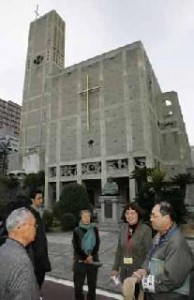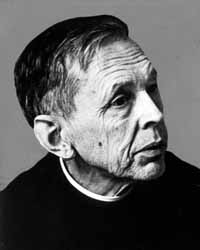Cathedral in Hiroshima guides wishes for peace
Mar. 31, 2008
by Hideshi Iwasaki, Staff Writer
The Memorial Cathedral for World Peace in downtown Hiroshima is designated by the national government as an important cultural property. At this cathedral, Catholic parishioners serve as volunteer guides providing tours to visitors. The cathedral was built a half-century ago with monetary and in-kind contributions from people throughout the world to pray for the repose of the A-bomb victims and for the realization of world peace.
The construction of the cathedral, with a tower 45 meters tall, was completed on August 6, 1954, nine years after the bombing. Guiding visitors through the hushed grandeur of the main hall, Kazuhiro Katsura, 62, of Hiroshima noted, “This pipe organ was donated by Cologne, Germany, a defeated country, too. It cost about three million yen at the time.”
The late Father Hugo Lassalle, who was exposed to the atomic bomb at the then Noboricho Roman Catholic Church, sought to build a cathedral after the war. He shared his vision for the cathedral with Pope Pius XII, explaining that it would be dedicated to the memory of the A-bomb victims and serve as a prayer for the love and peace of humankind. During visits to Europe, the United States, and other places, Father Lassalle spoke about the tragedy of the atomic bombing and solicited donations for the construction of the cathedral. He received contributions from all over the world as well as decorative items like stained glass windows and bells.
Each donated item is engraved with a message. The bronze front doors, provided by Dusseldorf, Germany, bear the inscription, “Love is the gate of peace.” Mr. Katsura pointed out this inscription and remarked to the visitors, “What do you think of this message? These are words to remember.” His tour of the cathedral lasted over an hour and ended at the top of the tower, a view that overlooks the city.
Mr. Katsura avoids impressing his own views of peace on visitors during his tours. “Peace can only be built up brick by brick, from within each person. I feel the experience of the cathedral itself provides visitors with a good opportunity to think about peace.”
Kazunari Iwasaki, 25, a tourist from Hyogo Prefecture, had not been aware of the existence of the cathedral before coming to Hiroshima. He happened to stop by and so he joined the tour. He commented, “I’m impressed that so many donations were made, from around the world, during the chaos of the postwar period for the purpose of building this cathedral.”
The parishioners began to serve as volunteer guides in 1999 when they saw that visitors felt hesitant to look freely around the church. From 10:00a.m. to 4:00p.m., twelve people take turns guiding a steady stream of visitors through the cathedral, including students on school field trips, pilgrims from Japan and abroad, and architects interested in the building’s design. The number of group visitors alone reaches 3,500 to 4,000 a year. And since 2006, when the cathedral was designated an important cultural property, the flow of visitors has increased.
Hiromi Fujita, 71, leader of the volunteer guides, remarked, “The cathedral was built by people from around the world, transcending ideology, religion, and race. I would like to convey their wishes of peace to our visitors.” Miwako Toi, 64, another volunteer guide, added, “After I became a guide, I came to realize how remarkable the cathedral is. This church is filled with the world’s wishes for peace.” When an earthquake shook Hiroshima in 2001, letters of concern were sent from students who had visited the cathedral. “Was the church damaged?” they wondered. This is just one example that shows how visitors share the “heart of Hiroshima.”
Father Takashi Koezuka of the Roman Catholic Diocese of Hiroshima offered the observation that “While the A-bomb Dome is a sign of the cruel side of human beings, the Memorial Cathedral for World Peace conveys a positive message of humanity appealing for no more war.” Father Koezuka is grateful for the volunteer guides, whose efforts are unique among churches in Japan. He says, “It’s wonderful to see them personifying the spirit of Father Lassalle.”
Keywords
Father Hugo Lassalle
Father Lassalle was born in Germany in 1898. He came to Japan as a Jesuit missionary in 1929 and, from 1939, he served in Hiroshima. He acquired Japanese nationality in 1948 and adopted the name Makibi Enomiya. In 1968, he was made an honorary citizen of Hiroshima. Father Lassalle died in Germany at the age of 91.
Memorial Cathedral for World Peace
The church was designed by architect Togo Murano (1891-1984) and construction began in 1950. Due to mounting costs and prolonged fundraising, it took four full years to complete the cathedral. At the time of construction, the cathedral cost approximately 100 million yen. The Memorial Cathedral for World Peace, while the official chair of the Diocese of Hiroshima, also serves in the role of Noboricho Church. As a pioneering work of postwar reconstruction in the city devastated by the atomic bombing, the building was designated as an important cultural property in July 2006.
The Memorial Cathedral for World Peace in downtown Hiroshima is designated by the national government as an important cultural property. At this cathedral, Catholic parishioners serve as volunteer guides providing tours to visitors. The cathedral was built a half-century ago with monetary and in-kind contributions from people throughout the world to pray for the repose of the A-bomb victims and for the realization of world peace.
The construction of the cathedral, with a tower 45 meters tall, was completed on August 6, 1954, nine years after the bombing. Guiding visitors through the hushed grandeur of the main hall, Kazuhiro Katsura, 62, of Hiroshima noted, “This pipe organ was donated by Cologne, Germany, a defeated country, too. It cost about three million yen at the time.”
The late Father Hugo Lassalle, who was exposed to the atomic bomb at the then Noboricho Roman Catholic Church, sought to build a cathedral after the war. He shared his vision for the cathedral with Pope Pius XII, explaining that it would be dedicated to the memory of the A-bomb victims and serve as a prayer for the love and peace of humankind. During visits to Europe, the United States, and other places, Father Lassalle spoke about the tragedy of the atomic bombing and solicited donations for the construction of the cathedral. He received contributions from all over the world as well as decorative items like stained glass windows and bells.
Each donated item is engraved with a message. The bronze front doors, provided by Dusseldorf, Germany, bear the inscription, “Love is the gate of peace.” Mr. Katsura pointed out this inscription and remarked to the visitors, “What do you think of this message? These are words to remember.” His tour of the cathedral lasted over an hour and ended at the top of the tower, a view that overlooks the city.
Mr. Katsura avoids impressing his own views of peace on visitors during his tours. “Peace can only be built up brick by brick, from within each person. I feel the experience of the cathedral itself provides visitors with a good opportunity to think about peace.”
Kazunari Iwasaki, 25, a tourist from Hyogo Prefecture, had not been aware of the existence of the cathedral before coming to Hiroshima. He happened to stop by and so he joined the tour. He commented, “I’m impressed that so many donations were made, from around the world, during the chaos of the postwar period for the purpose of building this cathedral.”
The parishioners began to serve as volunteer guides in 1999 when they saw that visitors felt hesitant to look freely around the church. From 10:00a.m. to 4:00p.m., twelve people take turns guiding a steady stream of visitors through the cathedral, including students on school field trips, pilgrims from Japan and abroad, and architects interested in the building’s design. The number of group visitors alone reaches 3,500 to 4,000 a year. And since 2006, when the cathedral was designated an important cultural property, the flow of visitors has increased.
Hiromi Fujita, 71, leader of the volunteer guides, remarked, “The cathedral was built by people from around the world, transcending ideology, religion, and race. I would like to convey their wishes of peace to our visitors.” Miwako Toi, 64, another volunteer guide, added, “After I became a guide, I came to realize how remarkable the cathedral is. This church is filled with the world’s wishes for peace.” When an earthquake shook Hiroshima in 2001, letters of concern were sent from students who had visited the cathedral. “Was the church damaged?” they wondered. This is just one example that shows how visitors share the “heart of Hiroshima.”
Father Takashi Koezuka of the Roman Catholic Diocese of Hiroshima offered the observation that “While the A-bomb Dome is a sign of the cruel side of human beings, the Memorial Cathedral for World Peace conveys a positive message of humanity appealing for no more war.” Father Koezuka is grateful for the volunteer guides, whose efforts are unique among churches in Japan. He says, “It’s wonderful to see them personifying the spirit of Father Lassalle.”
Keywords
Father Hugo Lassalle
Father Lassalle was born in Germany in 1898. He came to Japan as a Jesuit missionary in 1929 and, from 1939, he served in Hiroshima. He acquired Japanese nationality in 1948 and adopted the name Makibi Enomiya. In 1968, he was made an honorary citizen of Hiroshima. Father Lassalle died in Germany at the age of 91.
Memorial Cathedral for World Peace
The church was designed by architect Togo Murano (1891-1984) and construction began in 1950. Due to mounting costs and prolonged fundraising, it took four full years to complete the cathedral. At the time of construction, the cathedral cost approximately 100 million yen. The Memorial Cathedral for World Peace, while the official chair of the Diocese of Hiroshima, also serves in the role of Noboricho Church. As a pioneering work of postwar reconstruction in the city devastated by the atomic bombing, the building was designated as an important cultural property in July 2006.









